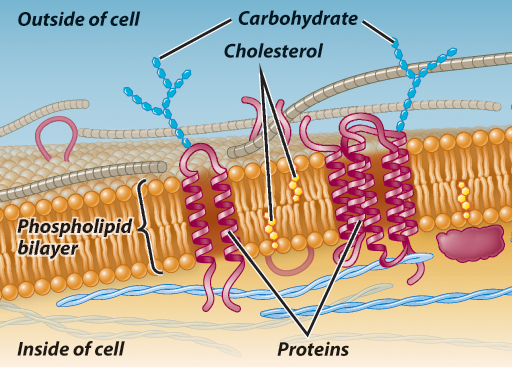Eukaryotic Cell Tour
INTRODUCTION
A eukaryote [Gr. eu: true + karyon: kernel or nucleus] is an organism that contains its genetic information within a cellular compartment called a nucleus. All animals, plants, fungi, and protists are eukaryotes. All other life, in the domains Archaebacteria and Eubacteria, are prokaryotes and lack this distinguishing membranous structure. In addition to the nucleus, a eukaryotic cell contains a number of other organelles that prokaryotes cells do not. These include membranous compartments such as the endoplasmic reticulum, the Golgi apparatus, the mitochondrion, and, in certain eukaryotes, the chloroplast. The membranes function in part to separate the interiors of the compartments from the surrounding cytoplasm, allowing the compartments to maintain the proper environments—distinct from the cytosol—for particular biochemical reactions to take place. In addition to the membranous organelles, eukaryotic cells are unique in having a cytoskeleton, a structure that is lacking in prokaryotic cells. The cytoskeleton provides the cell with support and a mechanism for movement.
A plant cell contains components of a typical eukaryotic cell. It also contains chloroplasts, which are found only in plants and other organisms that use light energy to make carbohydrates.
Click on a label to go to a mini-tutorial on a structure. In a mini-tutorial click on a label for additional information.
Click on a label to go to a mini-tutorial on a structure. In a mini-tutorial click on a label for additional information.
CONCLUSION
 All eukaryotic cells contain a nucleus at some time in their development. Most eukaryotic cells also
contain the other organelles described in this tutorial, although only photosynthetic cells contain
chloroplasts. The presence and abundance of particular organelles is a clue to the function of a cell.
For example, certain ovarian cells and any other type of cell that produces steroids typically
contain enormous quantities of smooth endoplasmic reticulum. In addition to other functions,
the smooth endoplasmic reticulum synthesizes steroids for a cell. As another example, cells
that function as factories for protein secretion—for example, antibody-secreting cells of the
immune system—must have abundant rough endoplasmic reticulum. The rough endoplasmic reticulum is
the site where ribosomes synthesize proteins that are destined for secretion. The organelles within
eukaryotic cells have unique chemical compositions and functions. In a multicellular organism with
many types of differentiated cells, the presence and abundance of certain organelles are important
factors in determining the cell's overall function.
All eukaryotic cells contain a nucleus at some time in their development. Most eukaryotic cells also
contain the other organelles described in this tutorial, although only photosynthetic cells contain
chloroplasts. The presence and abundance of particular organelles is a clue to the function of a cell.
For example, certain ovarian cells and any other type of cell that produces steroids typically
contain enormous quantities of smooth endoplasmic reticulum. In addition to other functions,
the smooth endoplasmic reticulum synthesizes steroids for a cell. As another example, cells
that function as factories for protein secretion—for example, antibody-secreting cells of the
immune system—must have abundant rough endoplasmic reticulum. The rough endoplasmic reticulum is
the site where ribosomes synthesize proteins that are destined for secretion. The organelles within
eukaryotic cells have unique chemical compositions and functions. In a multicellular organism with
many types of differentiated cells, the presence and abundance of certain organelles are important
factors in determining the cell's overall function.



